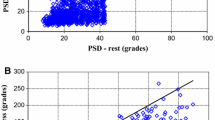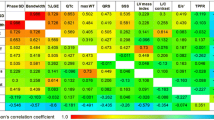Abstract
Purpose
The aim of this study was to evaluate the prognostic value of additional evaluation of left ventricular mechanical dyssynchrony (LVMD) by gated myocardial perfusion single-photon emission computed tomography (GMPS) in patients with acute myocardial infarction (MI) and multivessel disease.
Methods
One hundred and nine acute MI patients with >50 % stenosis in at least one non-culprit artery who underwent GMPS within 2 weeks were enrolled. All patients underwent successful revascularization of the culprit arteries. Those with previous MI, atrial fibrillation, or frequent ventricular premature complexes, cardiac devices, significant patient motion, or procedure-related events were excluded. Phase standard deviation (PSD) and phase histogram bandwidth (PBW) were measured for assessment of LVMD. Patients were followed up for a median of 26 months after index MI, for composite major adverse cardiac events (MACE), which consisted with all-cause death, unplanned hospitalization due to heart failure and severe ventricular arrhythmias (sustained ventricular tachycardia or ventricular fibrillation). Independent predictors of MACE were evaluated.
Results
MACE occurred in 22 patients (20 %). Stress PSD (53.3 ± 17.3° vs. 35.3 ± 18.9°; p <0.001), stress PBW (147.6 ± 54.6° vs. 96.8 ± 59.2°; p = 0.001) and resting PBW (126.8 ± 37.5° vs. 96.6 ± 48.9°; p = 0.001) were significantly higher in patients with MACE compared to those without. Multivariate analysis revealed that stress PSD ≥45.5° and stress PBW ≥126.0° were predictive of MACE, as well as suboptimal non-culprit artery revascularization (SNR) and renin-angiotensin system (RAS) blockade medication. Higher stress PSD and stress PBW were associated with poorer prognosis both in patients with and without SNR, and those with RAS blockade medication, but not in those without RAS blockade medication.
Conclusions
LVMD measured by GMPS showed added prognostic value in acute MI with multivessel disease. GMPS could serve as a comprehensive evaluation imaging tool in patients with acute MI and multivessel disease.


Similar content being viewed by others
References
Nagueh SF. Mechanical dyssynchrony in congestive heart failure: diagnostic and therapeutic implications. J Am Coll Cardiol. 2008;51:18–22.
Leong DP, Hoogslag GE, Piers SRD, et al. The relationship between time from myocardial infarction, left ventricular dyssynchrony, and the risk for ventricular arrhythmia: speckle-tracking echocardiographic analysis. J Am Soc Echocardiogr. 2015;28:470–7.
Baller D, Wolpers HG, Zipfel J, Hoeft A, Hellige G. Unfavorable effects of ventricular pacing on myocardial energetics. Basic Res Cardiol. 1981;76:115–23.
Takeuchi M, Fujitani K, Kurogane K, et al. Effects of left ventricular asynchrony on time constant and extrapolated pressure of left ventricular pressure decay in coronary artery disease. J Am Coll Cardiol. 1985;6:597–602.
Zile MR, Blaustein AS, Shimizu G, Gaasch WH. Right ventricular pacing reduces the rate of left ventricular relaxation and filling. J Am Coll Cardiol. 1987;10:702–9.
Shin SH, Hung CL, Uno H, et al. Mechanical dyssynchrony after myocardial infarction in patients with left ventricular dysfunction, heart failure, or both. Circulation. 2010;121:1096–103.
Mollema SA, Liem SS, Suffoletto MS, et al. Left ventricular dyssynchrony acutely after myocardial infarction predicts left ventricular remodeling. J Am Coll Cardiol. 2007;50:1532–40.
Hida S, Chikamori T, Tanaka H, et al. Diagnostic value of left ventricular dyssynchrony after exercise and at rest in the detection of multivessel coronary Artery disease on single-photon emission computed tomography. Circ J. 2012;76:1942–52.
Huang WS, Huang CH, Lee CL, Chen CP, Hung GU, Chen J. Relation of early post-stress left ventricular dyssynchrony and the extent of angiographic coronary artery disease. J Nucl Cardiol. 2014;21:1048–56.
Sorajja P, Gersh BJ, Cox DA, et al. Impact of multivessel disease on reperfusion success and clinical outcomes in patients undergoing primary percutaneous coronary intervention for acute myocardial infarction. Eur Heart J. 2007;28:1709–16.
Brener SJ, Milford-Beland S, Roe MT, et al. Culprit-only or multivessel revascularization in patients with acute coronary syndromes: an American College of Cardiology National Cardiovascular Database Registry report. Am Heart J. 2008;155:140–6.
Kim MC, Jeong MH, Kim SH, Hong YJ, Kim JH, Ahn Y. Current status of coronary intervention in patients with ST-segment elevation myocardial infarction and multivessel coronary artery disease. Korean Circ J. 2014;44:131–8.
Bajaj NS, Kalra R, Aggarwal H, et al. Comparison of approaches to revascularization in patients with multivessel coronary artery disease presenting with ST-segment elevation myocardial infarction: meta-analyses of randomized control trials. J Am Heart Assoc. 2015. doi:10.1161/JAHA.115.002540.
Jang JS, Spertus JA, Arnold SV, et al. Impact of multivessel revascularization on health status outcomes in patients with ST-segment elevation myocardial infarction and multivessel coronary artery disease. J Am Coll Cardiol. 2015;66:2104–13.
Park H, Hong YJ, Rhew SH, et al. Effect of revascularization strategy in patients with acute myocardial infarction and renal insufficiency with multivessel disease. Korean J Intern Med. 2015;30:177–90.
Sardella G, Lucisano L, Garbo R, et al. Single-staged compared with multi-staged PCI in multivessel NSTEMI patients: the SMILE Trial. J Am Coll Cardiol. 2016;67:264–72.
Engstrom T, Kelbaek H, Helqvist S, et al. Complete revascularisation versus treatment of the culprit lesion only in patients with ST-segment elevation myocardial infarction and multivessel disease (DANAMI-3-PRIMULTI): an open-label, randomised controlled trial. Lancet. 2015;386:665–71.
Chen J, Garcia EV, Bax JJ, Iskandrian AE, Borges-Neto S, Soman P. SPECT myocardial perfusion imaging for the assessment of left ventricular mechanical dyssynchrony. J Nucl Cardiol. 2011;18:685–94.
Slomka PJ, Fieno D, Thomson L, et al. Automatic detection and size quantification of infarcts by myocardial perfusion SPECT: clinical validation by delayed-enhancement MRI. J Nucl Med. 2005;46:728–35.
Mark DB, Nelson CL, Califf RM, et al. Continuing evolution of therapy for coronary artery disease. Initial results from the era of coronary angioplasty. Circulation. 1994;89:2015–25.
Taqueti VR, Hachamovitch R, Murthy VL, et al. Global coronary flow reserve is associated with adverse cardiovascular events independently of luminal angiographic severity and modifies the effect of early revascularization. Circulation. 2015;131:19–27.
Haqqani HM, Kalman JM, Roberts-Thomson KC, et al. Fundamental differences in electrophysiologic and electroanatomic substrate between ischemic cardiomyopathy patients with and without clinical ventricular tachycardia. J Am Coll Cardiol. 2009;54:166–73.
Murrow J, Esteves F, Galt J, et al. Characterization of mechanical dyssynchrony measured by gated single photon emission computed tomography phase analysis after acute ST-elevation myocardial infarction. J Nucl Cardiol. 2011;18:912–9.
Nakamura Y, Yoshiyama M, Omura T, et al. Beneficial effects of combination of ACE inhibitor and angiotensin II type 1 receptor blocker on cardiac remodeling in rat myocardial infarction. Cardiovasc Res. 2003;57:48–54.
Yoshiyama M, Nakamura Y, Omura T, et al. Angiotensin converting enzyme inhibitor prevents left ventricular remodelling after myocardial infarction in angiotensin II type 1 receptor knockout mice. Heart. 2005;91:1080–5.
Henneman MM, Chen J, Ypenburg C, et al. Phase analysis of gated myocardial perfusion single-photon emission computed tomography compared with tissue Doppler imaging for the assessment of left ventricular dyssynchrony. J Am Coll Cardiol. 2007;49:1708–14.
Uebleis C, Hellweger S, Laubender RP, et al. Left ventricular dyssynchrony assessed by gated SPECT phase analysis is an independent predictor of death in patients with advanced coronary artery disease and reduced left ventricular function not undergoing cardiac resynchronization therapy. Eur J Nucl Med Mol Imaging. 2012;39:1561–9.
Author information
Authors and Affiliations
Corresponding author
Ethics declarations
Conflict of interest
Sang-Geon Cho, Zeenat Jabin, Ki Seong Park, Jahae Kim, Sae-Ryung Kang, Seong Young Kwon, Geum-Cheol Jeong, Minchul Song, Jong Sang Kim, Jae Yeong Cho, Hyun Kuk Kim, Ho-Chun Song, Jung-Joon Min, and Hee-Seung Bom declare that they have no conflict of interest.
Ethical approval
All procedures performed in studies involving human participants were in accordance with the ethical standards of the institutional and/or national research committee and with the 1964 Helsinki declaration and its later amendments or comparable ethical standards.
Informed consent
The requirement to obtain was waived in this retrospective study.
Additional information
Sang-Geon Cho and Zeenat Jabin equally contributed to this work as co-first authors.
Electronic supplementary material
Below is the link to the electronic supplementary material.
ESM 1
(DOCX 1396 kb)
Rights and permissions
About this article
Cite this article
Cho, SG., Jabin, Z., Park, K.S. et al. Clinical values of left ventricular mechanical dyssynchrony assessment by gated myocardial perfusion SPECT in patients with acute myocardial infarction and multivessel disease. Eur J Nucl Med Mol Imaging 44, 259–266 (2017). https://doi.org/10.1007/s00259-016-3542-y
Received:
Accepted:
Published:
Issue Date:
DOI: https://doi.org/10.1007/s00259-016-3542-y




